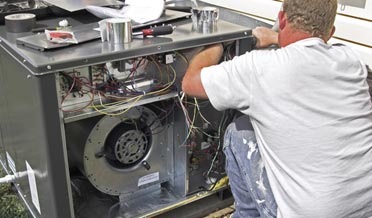Furnace Installation: Gas vs. Electric Comparison
Keeping warm during the winter is quite important in determining where humans can find habitation, and we are quite adept at finding clothing and heating sources to survive cold weather.
Over the years, our adaptations have moved us from survival to comfort to efficiency and environmental responsibilities. We have replaced open fireplaces with central heating, ventilation, and air conditioning (HVAC) systems that provide warmth and comfort to every room in the house.
In Texas, the most common types of HVAC heating systems are powered by natural gas and electricity. Electrical options include a heating element and heat pump technology. Which system type is best for your home? Here are some pros and cons for each to help you decide your best option.
Gas Furnace Installation Pros
- Natural gas burns at over 35000 Fahrenheit, so it is extremely effective at warming a space. The heat is collected in a heat exchanger, and the exhaust is vented outdoors. A blower motor moves this extremely warm air throughout the home at a lower air speed, so natural gas is considered very comfortable.
- Natural gas is quite inexpensive in our area, lowering the cost of heat.
- Natural gas furnaces are considered appropriate for older, drafty homes since they quickly overcome the infiltration of cold air.
- Natural gas is a very clean burning fuel. The complete combustion of natural gas produces water vapor and carbon dioxide.
- Natural gas furnaces receive efficiency ratings called annual fuel utilization efficiency, and furnace systems currently capture 90 to 98.5 percent of the available energy in natural gas. That is quite impressive.
Gas Furnace Installation Cons
- While natural gas is considered inexpensive, the cost of the equipment and installation is higher than electric furnace systems. However, the differences between these costs of the fuel and the equipment seem to offset each other.
- Natural gas-powered systems require careful annual maintenance since the hot water vapor produces rust that corrodes the walls of the sheet metal heat exchanger and exhaust vent. Even a small leak will allow exhaust to enter the home, and this must not happen.
- Natural gas systems last slightly shorter spans than electric systems.
Electric Furnace Installation Pros
- Electric-powered furnace systems heat a metal element to more than 23000 Fahrenheit, heating the air inside a chamber, and a blower motor moves the warm air throughout the home. All the energy is captured, so electric systems are AFUE-rated at 100 percent.
- Electric heat pump systems remove heat from the outside air and move it indoors, using the same equipment as an air conditioner, just reversing the process. Heat pump technology is 3 to 5 times more efficient than systems that generate heat using fuel.
- Electric systems are generally less expensive than gas-powered systems, and the installation cost is also lower.
- Electric systems last slightly longer than gas-powered systems.
Electric systems are carbon neutral since most electricity generated in Texas comes from natural gas-powered systems. However, the combustion happens away from the home.1
Electric Furnace Installation Cons
- The lower temperature of a heating element requires more air to circulate to produce the desired result, achieving comfort a little slower than natural gas. Heat pump systems require even more air movement.
- Heat pump systems are efficient if heat is available outdoors. When the temperature drops below 320 Fahrenheit, an auxiliary system is required—either natural gas or electric element heat is used as a secondary heat source.
- Electricity is a bit more expensive than natural gas; however, the cost of the fuel is generally offset by the higher cost of equipment and installation for gas-powered systems.
- Electric systems also require annual cleaning and inspection to prevent dust from obstructing the free movement of air.
If you would like more information about Furnace Installation, Doctor Cool Can Help!
Let Doctor Cool help with your Furnace Installation questions. Call Doctor Cool & Professor Heat today at 281-338-8751 or email Doctor Cool.
1 https://comptroller.texas.gov/economy/fiscal-notes/2020/august/ercot.php#:~:text=Early%20power%20plants%20produced%20electricity,as%20renewable%20resources%2C%20primarily%20wind
